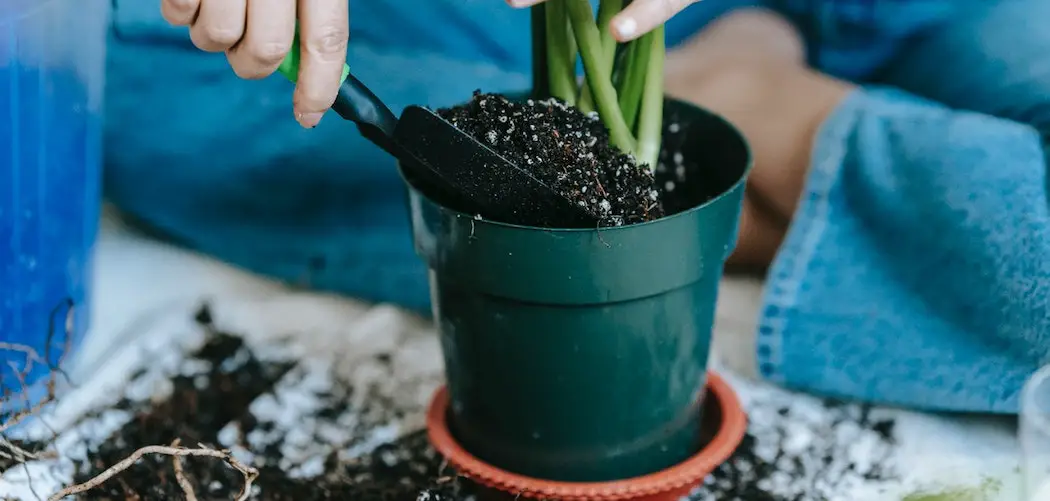Getting the drainage right for your indoor plants is critical if you want them to survive.
Although there are many different materials and techniques to achieve good drainage, you don’t want to risk it, because the truth is some work much better than others.
In this article, I am going to tell you exactly what the best type of drainage for indoor plants is, as well as what to avoid.
Here Is The Best Drainage Drainage For Indoor Plants:
Although it depends on the species, as a general rule the best drainage for indoor plants is mixing perlite or vermiculite with the plant’s soil to help pull water out of it and release it back gradually. Also, always make sure that your plant’s container has drainage holes.
There are many things to explore in order to understand drainage properly. Fortunately, we’ve compiled all the answers you need to know:
Do All Indoor Plants Need Drainage?
Yes, almost all indoor plants need drainage of some sort because otherwise, their soil will remain wet. That means you need to make sure you use at least one form of drainage material when you are potting up a plant, as well as having drainage holes.
Some plants like the Spider Plant or Lucky Bamboo are less fussy about this, while others like Succulents are intensely fussy, and you may need to incorporate several kinds of drainage if your plants are going to thrive.
As a general rule, if your plant prefers marshy conditions, you will need less drainage, whereas desert-dwelling plants will need a lot more.
It’s a good idea to research the specific requirements of your plant before you pot it into a new container.
Having the right drainage setup makes it far easier to water your plant properly and keep it in the right conditions. If you don’t set the drainage up correctly, you’ll find that you are constantly struggling to keep your plant wet enough or dry enough, depending on the species.
You should therefore take the time to get this right during potting, making the ongoing care easier.
What Happens If Your Plants Don’t Have Drainage?
If your plants don’t have enough drainage, they will struggle to survive. Plants need their roots to dry out a little from time to time, and they need oxygen to circulate around their roots. If water is sitting around the roots, the air can’t flow over them which will eventually lead to root rot.
Lack of good drainage causes anaerobic conditions where there is little to no oxygen, and this in turn can lead to the spread of damaging bacteria.
Your plant’s roots will start to break down and rot if they are perpetually soggy, and this will kill your plant quickly.
Root rot can kill even a healthy, strong plant surprisingly fast.
Even in mild cases, lack of drainage will make your plant sickly and unhappy, and needs to be avoided.
Types Of Drainage Explained
So, what drainage options are there?
Hole In The Pot (Drainage Holes)
One of the most important drainage techniques involves making sure that there is at least one hole in the bottom of your plant’s container. This allows water to run out of the bottom of the pot, and it’s essential for almost all planting setups.
Without this hole, the water has nowhere to go, especially in a plastic container. If the planter you want to use does not have at least one hole, you will need to make one.
As a rough guide, two to four holes are better than one.
Mixed Potting Medium
A mixed potting medium means mixing other materials alongside your potting soil.
Using a potting medium that has chunks of orchid bark and peat moss in it can help the soil to drain well. Compacted soil holds on to moisture, so if you can ensure the potting mix is loose and comprised of different organic materials, it should release the water.
There are plenty of things you can add to the potting medium to make it drain better, and we’ll cover some in the next section.
Raised Pot
Lifting the pot may help it to drain better. If the pot sits flush against its saucer, it’s harder for water to flow out of the bottom. You can slightly raise the pot with a layer of gravel or other inorganic material to increase the flow from the drainage hole.
This does not mean double potting. Double potting doesn’t help with drainage.
Best Drainage Material For Indoor Plants
The best drainage material will depend on your plant type. As a general rule, the best drainage material for most plants is either perlite or vermiculite. Though vermiculite is slightly superior, they are both excellent for water and nutrient retention.
Here are the different things you can add to your plant’s container to improve the drainage:
Orchid Bark
Great for: Orchids, Air plants, Anthurium, Monstera, etc.
Adding a tough material like bark prevents the soil from getting too compact, and this helps the water to flow. Orchid bark increases aeration and drainage, but it will gradually break down, so it will need replacing eventually.
Perlite
Great for: Cacti and Succulents, plants that need very good drainage
Many people use perlite in their containers to increase drainage. This can be mixed through the soil, and it lasts longer than things like orchid bark. It’s also lightweight, so it won’t make your container heavy.
It absorbs water, pulling it out of the soil and preventing it from staying wet for too long. Gradually, it will release the water back so the plant still gets plenty to drink.
Vermiculite
Great for: Calathea, Peace lily, Philodendron, Ferns, etc.
Vermiculite is a highly porous, lightweight material that also absorbs water. Similar to perlite, it will release it back gradually. It improves the aeration in the pot and helps to ensure that the roots aren’t sitting in water. It does break down eventually.
Coarse Sand
Great for: Geranium, Rosemary, some Hibiscus species
Sand does not absorb water, but it will help the soil drain because it creates easier routes for the water to run through. You must use coarse sand, however; fine sand will create a cement-like substance that will make the drainage worse. Sand won’t break down.
Drainage Layer Vs Drainage Holes
Almost all plant pots have a drainage hole, but you may be wondering whether you also need to add a drainage layer.
It’s best to treat drainage layers with caution. They have been suggested for years, but they can cause problems.
If there is no drainage layer, water usually runs down through the container as a result of gravity. The soil clings to it, but the force of gravity gradually pulls it down through the pot.
When it reaches the bottom, it flows out into the saucer. Some people think that if you put a layer of gravel there, the water can drain more freely. However, recent research has shown that this actually makes drainage worse because it raises the level of the wet soil and brings it closer to the roots.
The soil in the pot clings to moisture, and the gravel does not pull it away. It, therefore, does not improve the drainage, and simply positions the wet soil closer to the plant’s roots. Drainage layers should be avoided.
Another problem with a drainage layer is it can clog up the plant’s drainage holes.
As opposed to a drainage layer, drainage holes are essential and perfectly safe. You need a drainage hole, not a drainage layer if your plants are not to get waterlogged.
Best Indoor Plants For Non-Drainage Pots
If you have a container you really want to use but there are no drainage holes, you might be wondering if any plants will tolerate this. If you are careful not to over-water, you do have a few options, including:
-
Snake plants
-
Spider plants
-
Coleus
-
Crotons
-
Chinese Evergreens
-
Dumbcanes
-
Schefflera
-
Pothos
-
Lucky bamboo
All of these plants will tolerate having minimal drainage, but you must still make sure they don’t get waterlogged.
Best Drainage Pots For Indoor Plants
In general, it doesn’t matter whether your plant is large or small; it needs good drainage. Small plants may be more vulnerable to root rot since they have fewer roots to depend upon, but even large plants need great drainage.
Best Large Drainage Pots
The best large pots that offer good drainage usually have 2 to 4 drainage holes. Also, It’s best to stick with materials such as plastic or ceramic.
Examples:
- These 8 Inch Planters come in a variety of colors and are ideal for helping bigger plants drain. You can take the saucer off the bottom to empty it when necessary.
- If you would rather have a container that looks more rugged and interesting, this Stoneware Flower Plant Pot should work well, and you again have a few color options.
Best Small Drainage Pots
The best small pots for drainage are usually made out of terracotta or ceramic, and they can get away with using a single drainage hole because of the smaller overall root size.
Examples:
- Terracotta is a breathable material that drains well, so these D’vine Dev Terracotta Pots are ideal for smaller plants.
- Alternatively, if you like a more unusual pot, try these Brajtt Ceramic Succulent Planter Pots, which come in sets of 12.
Both options have drainage holes in them.
How To Improve Drainage In Indoor Plants
If you find that the soil is not drying and the drainage in your pot is insufficient, the best fix usually involves mixing some drainage material into the potting medium.
To do this, remove your plant from its pot and shake the soil off its roots.
Take some fresh potting compost and mix it with orchid bark, perlite, vermiculite, or all three. Repot the plant using this mixture, and you should find the drainage has improved.
What Can You Put On The Bottom Of Your Indoor Plants For Drainage?
You don’t have to put any layer at the bottom of your indoor plants to improve drainage. It’s incorrectly thought that drainage layers are necessary, but they can do more harm than good and it’s best to avoid them.
The best way to improve the drainage of your pot is to improve the drainage of the potting medium, rather than adding a layer at the bottom.
Use well-draining soil and drainage holes instead.
Do You Need To Put Rocks In The Bottom Of A Planter?
No, you don’t need to put rocks at the bottom of a planter. A layer of gravel or rocks will not improve drainage and could even clog up the pot’s drainage holes.
Also, the soil will still hold onto the moisture with as much force as it does when resting against the base of a pot.
It is therefore better not to put anything at the bottom of the container, but instead to ensure your soil drains well throughout the container.
Conclusion
Drainage is a crucial aspect of caring for houseplants, so take the time to ensure your plants have superb drainage in their containers using the information above.
Hopefully, you now have a better understanding of all the different materials and techniques you can use to achieve great drainage.
You should also find out what your plant’s drainage needs are, as some prefer wetter soil than others.


